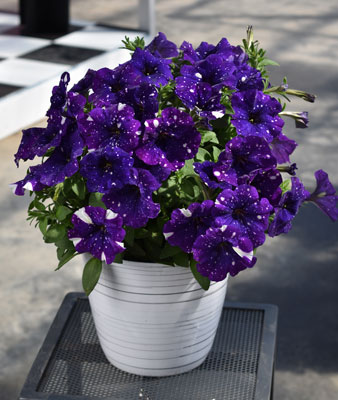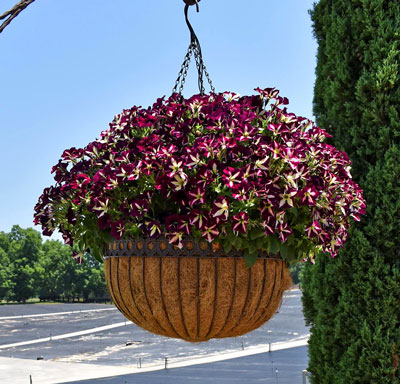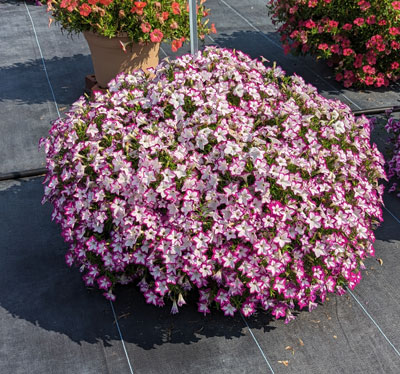2/1/2024
The Original Punk Rock Petunia
Bart Hayes

In a world where star patterns and picotees were the only unique flower patterns petunias had to offer, a little more than a decade ago Westhoff introduced the Crazytunia line of petunias and changed the way they were perceived moving forward. A plant category that was quickly becoming old fashioned was suddenly re-invigorated with new colors and patterns that brought novelty to the seasoned garden enthusiast and grabbed the attention of a new generation of gardeners. This renewed interest spurred all breeders to push breeding forward and our entire industry has benefitted from this renewed focus on the diversity within this product class.
Pictured: The Petunia DiscoBall Series features compact, mounding plants with a speckled flower pattern. Perfect for small pots.
Westhoff didn’t stop with simple star patterns, however. We continued the petunia revolution and developed new series and colors that pushed the envelope of what is genetically possible. Whether by working to bring the “Orange Petunia” back to the North American market, expanding into new flower patterns or expanding the Crazytunia series to over 50 varieties to choose from, Westhoff had become synonymous with this new wave of genetic diversity.
However, just like any trend in our industry, eventually the new isn’t enough, and these weird new colors and patterns must become easier for growers and offer improved performance for the consumer. Crazytunias, with their reputation for not only crazy colors, but also wildly diverse growth habits and timing, had some growing up to do. Just like when I got this job, it was time for Crazytunias to cut their hair and take out those scary piercings.
So, for the past several years, most of the attention in breeding selections for the Crazytunia series has focused on earlier flowering and refining the growth habit to be initially upright growing, eventually maturing into a mounding habit in the garden. We’ve found that although some are produced for hanging baskets, the majority of Crazytunia varieties are produced for that impulse purchase of an intense pop of “cool” in the garden or combination planter. Products like this are usually produced and sold in a smaller pot, so this less vigorous, tidier habit tends to be better for growers and end consumers.
 Pictured: The Crazytunia series still has a mohawk, but drives a minivan. Along with the not-your-everyday star pattern petunias, you get a very flexible mounding habit, early blooming and great garden performance.
Pictured: The Crazytunia series still has a mohawk, but drives a minivan. Along with the not-your-everyday star pattern petunias, you get a very flexible mounding habit, early blooming and great garden performance.
Then, for the same reason, Westhoff introduced a compact speckled patterned petunia for small pots as well this year, called DiscoBall, to provide even more options for your customers. But for standout hanging baskets, the relatively new Flower Shower series is a better choice, with vigorous, semi-trailing habits. There are solid colors, but some of the unique colors and star patterns, as well. In fact, many of the varieties in the Flower Shower series were originally Crazytunias, but had the right habit and exhibited really good weather tolerance, so made better sense to be in this newer series.
Overall, Westhoff is still the leader in unique colors and patterns, but by refining their performance and organizing them into consistent series, we’re just making them a bit more grower-friendly while improving their post-purchase life for our end users.
Propagation
Propagating any of these unique petunia varieties is fairly similar to regular petunia propagation. Unrooted cuttings are best stuck in a 102-tray using an engineered soilless media. Mist cuttings only enough to keep the soil moist and the cuttings turgid. I recommend treating with a rooting hormone, typically KIBA at 100 ppm, mostly to ensure rooting uniformity, as well as a broad-spectrum fungicide. Callus formation is quite rapid and you should see root initials within five to seven days of sticking.
Reduce mist and ensure that more thor-ough watering from overhead is less frequent to allow for some wet-and-dry-cycle formation—you want roots to chase the water and they won’t do that unless there’s some occasional soil drying. Initial feeding of a well-balanced fertilizer at 100 to 150 ppm is recommended, as well as monitoring vegetative growth—here is where it gets sticky.
Two choices: mechanically pinch or chemically pinch. Both have benefits and unintended side effects. Mechanical pinching introduces the possibility of disease transmission, but works with the natural tendency of the plant to branch. A chemical pinch eliminates this potential disease transmission, but some chemicals have additional effects besides height reduction and branching. Studies have shown that daminozide (B-Nine) can negatively impact flower pattern/color expression and Ethephon (Florel) can impact flower timing. This isn’t a deal-breaker, but growers should expect that these effects can extend into the finished pot, with delayed flowering and the first initial flowers not exhibiting the standard pattern.
Finishing
Once plants are transplanted into their finished pots, growing is fairly straight forward. Fertilize at medium to high rates around 250 ppm N. A specialty fertilizer or the addition of a minor elements fertilizer is recommended to ensure pH stays low, between 5.4 and 6.2, and that there are sufficient micronutrients available, specifically Iron and Magnesium. I should also note that I’ve seen problems with certain novelty petunia varieties with insufficient Calcium uptake, mainly due to excessive humidity reducing transpiration, in the late propagation stages and shortly after transplanting. Good airflow and watering practices should reduce this possibility.
 Pictured: With simply unparalleled garden performance, the Flower Shower series was selected for weather tolerance, but with the cool colors and unique patterns that Westhoff has become best known.
Pictured: With simply unparalleled garden performance, the Flower Shower series was selected for weather tolerance, but with the cool colors and unique patterns that Westhoff has become best known.
For growth control, once transplants are established, allow the soil to dry slightly to encourage healthy root development, but also to control excessive growth. Lower temperatures, especially at night, are also effective. For chemical growth regulation, I prefer uniconizol or paclobutrazol since they seem to affect the flower color/pattern less. Follow the label for recommended rates and volumes, as well as in-house trailing to find what works best for your production. It’s because of this PGR sensitivity that Crazytunias have been selected for an upright/mounding habit—to avoid negatively affecting the very characteristic that consumers like about the variety.
Finally, the best growing advice I can give is to work closely with your sales representative or product specialist to find the varieties that best fit your production schedule and customer base. There will always be new varieties to trial, so plan on including a certain number of them in your production every year. This way the trials don’t get lost as easily and don’t end up being “extra plants” that end up going home with employees instead of in customer’s carts. GT

Bart Hayes is the Sales Manager for Westhoff.